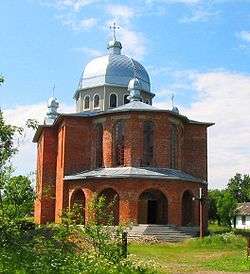Voinyliv
.jpg)

Voynyliv (Ukrainian: Войнилів / Voinyliv / Vojnyliv, Polish: Wojniłów / Voyneeloow, Russian: Войнилов / Voynilov / Voinilov) is an urban-type settlement in western Ukraine. Voynyliv is situated in Kalush Raion of Ivano-Frankivsk Oblast, ca. 100 km from Lviv. The closest city is Kalush to the west. The distance to the closest railway station in Kalush is 22 km and it is 42 km from Voynyliv to the city of Ivano-Frankivsk. Population: 2,727 (2016 est.)[1].
Voynyliv lies in the lowlands of the Dniester river basin and is located near the Sivka and Bolokhivka Rivers, the tributaries to the Dniester River.
Postal code for Voynyliv is 77316 and telephone code is +380 03472. In 2002-2005 there was built a school in Voynyliv designed for 689 students.
Within Kalush Raion there is also somewhat smaller village Dovhyi Voynyliv (ukr.: Long Voynyliv), which should not be mixed with the town of Voynyliv.
History
First historical mention about Voynyliv dates to the 15th century, namely in accounts of the battle of Turkish armies with Polish troops of king Jan III Sobieski of Poland. According to other sources it was founded in 1352 as village Prokopivka and received town privileges in 1443.
Prior to World War II, Voynyliv like most of western Ukraine, belonged to Poland and had ab. 1000 inhabitants. It was a seat of village commune (Polish: gmina) in the district (Polish: powiat) of Kalush. The population of the town consisted of Jews engaged in commerce as well as Poles and Ukrainians. There was Roman Catholic church in Voynyliv though it was taken down by Soviets in 1945. In inter-war period there existed the Society of Polish Landmen. Rich Polish landlords had estates in nearby villages of Serednye, Babyn and Dorokhiv. In 1926 the first independent district union of milkmen was started in Voynyliv with good results, after which other unions started to emerge.
There were two schools in town — one for men and one for women.
Coat of arms
Voynyliv had historical coat of arms, officially approved in 1689. It depicted a lion emerging from a fortress wall and holding the wreath in its paws. Similar design of town's coat of arms — a yellow lion on a blue background (national colours of Ukraine) with a fortress wall in the lower part, functions as official symbol of the town today.
Jewish community

The book Where Once We Walked states that before the war Voynyliv had a Jewish population of 944 persons. There was a Jewish temple in Voynyliv. Voynyliv Jewish community perished in the Holocaust, though some Jews stemming from Voynyliv are found in the US and United Kingtom from pre-war immigration. The remnants of Jewish cemetery in Voynyliv preserved.
References
- ↑ "Чисельність наявного населення України (Actual population of Ukraine)" (PDF) (in Ukrainian). State Statistics Service of Ukraine. Retrieved 19 July 2016.
Sources
- (in Polish) Wojniłów w Słowniku geograficznym Królestwa Polskiego (Voynyliv in the Geographic Dictionary of Polish Kingdom).
External links
| Wikimedia Commons has media related to Voynyliv. |
- Jewish genealogical website about Voynyliv
- Jewishgen page about Voynyliv.
- Voynyliv website by Bruce Drake.
- Photos of Voynyliv at Webshots.com
- Coat of Arms of Voynyliv
Coordinates: 49°7′46″N 24°29′40″E / 49.12944°N 24.49444°E